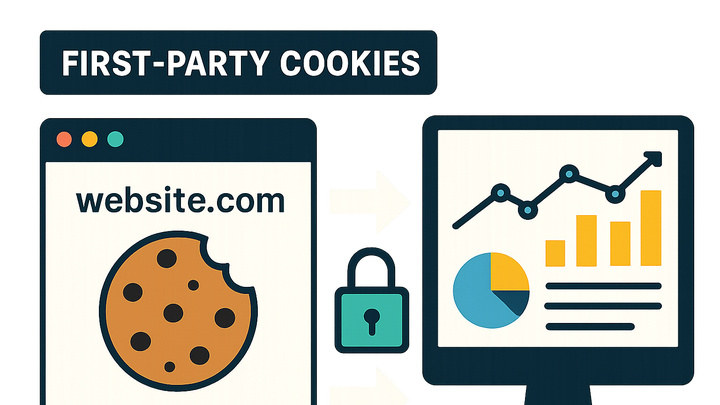Published on 2025-06-28T05:38:08Z
What Are First-Party Cookies? Examples and Implementation in Analytics
First-party cookies are small data files set by the domain of the website a user visits. They store information about user interactions, preferences, and session data directly on the browser, enabling precise user-level analytics without relying on external domains. In the analytics industry, first-party cookies are preferred for their compliance-friendly nature—they are less likely to be blocked by browsers or ad blockers and align better with privacy regulations like GDPR and CCPA. Platforms such as PlainSignal and Google Analytics 4 leverage first-party cookies to collect reliable data on pageviews, unique visitors, and conversion events. Because the cookies originate from your own domain, they provide more accurate attribution and reduce data loss compared to third-party alternatives. Implementing them correctly ensures robust tracking, improved data governance, and enhanced user trust.
First-party cookies
First-party cookies are browser files set by your own domain to track user behavior accurately and privately for analytics.
Definition and Importance
This section defines first-party cookies and explains their key role in web analytics.
-
What are first-party cookies?
First-party cookies are data files that a website sets within the user’s browser under the same domain. They store user-specific information, such as session IDs, language preferences, and authentication tokens.
-
Why they matter in analytics
Because they originate from your own domain, first-party cookies reliably capture user interactions without being blocked by modern browsers or ad blockers. This leads to more accurate reporting of metrics like pageviews, sessions, and conversions.
How They Work
An overview of the lifecycle of a first-party cookie, from creation to data transmission.
-
Creation and storage
When a user visits a website, the server responds with a Set-Cookie header or a JavaScript API call. The browser then stores the cookie tied to the site’s domain, including properties like name, value, expiration date, and scope.
-
Data collection process
Each time the user interacts with the site, the browser automatically sends the stored cookie back via the Cookie header. Analytics scripts parse this information to identify returning users, track sessions, and attribute events.
Benefits and Limitations
A balanced look at the advantages and challenges of using first-party cookies for analytics.
-
Benefits
- Improved data accuracy and user attribution
- Better privacy compliance
- Lower risk of blocking by browsers
-
Limitations
- Dependent on user consent and settings
- Limited lifespan based on expiration policy
- Cannot track users across multiple domains
Use Cases in Analytics
Examples of how first-party cookies power common analytics tasks.
-
User behavior tracking
Monitor pageviews, clicks, and scroll depth at the individual user level to understand engagement patterns over time.
-
Retention and cohort analysis
Group users by acquisition date and track their return rates over days, weeks, or months. This reveals product stickiness and churn trends.
-
Conversion funnel analysis
First-party cookies enable you to identify drop-off points within multi-step processes.
-
Identifying drop-off points
Analyze the stage where most users abandon the funnel to prioritize UX improvements.
-
Optimizing touchpoints
Test variations at critical steps to increase completion rates and overall conversions.
-
Implementing with SaaS Products
Guidance on adding first-party cookie tracking to your website using popular analytics platforms.
-
PlainSignal example
Insert the PlainSignal snippet before your site’s closing </head> tag to enable cookie-free, first-party analytics:
<link rel="preconnect" href="//eu.plainsignal.com/" crossorigin /> <script defer data-do="yourwebsitedomain.com" data-id="0GQV1xmtzQQ" data-api="//eu.plainsignal.com" src="//cdn.plainsignal.com/plainsignal-min.js"></script> -
GA4 example
Configure Google Analytics 4 to use first-party cookies by adding the gtag snippet to your site’s header:
<!-- Global site tag (gtag.js) - Google Analytics --> <script async src="https://www.googletagmanager.com/gtag/js?id=G-XXXXXXX"></script> <script> window.dataLayer = window.dataLayer || []; function gtag(){dataLayer.push(arguments);} gtag('js', new Date()); gtag('config', 'G-XXXXXXX', { 'cookie_flags': 'SameSite=Lax;Secure' }); </script>
Privacy and Compliance
How first-party cookies align with major privacy laws and user consent requirements.
-
Gdpr and ccpa considerations
Under GDPR and CCPA, first-party cookies used for analytics may still require user consent. Document your cookie policy and offer opt-out mechanisms to stay compliant.
-
Consent management
Integrate a consent management platform (CMP) to capture, store, and respect user choices around cookie tracking. Ensure scripts only fire after consent is granted.
Best Practices
Tips for effective and ethical use of first-party cookies in analytics.
-
Data governance
Establish clear policies on data retention, access controls, and regular audits to prevent misuse of cookie-derived data.
-
Cookie scope and expiration
Set appropriate expiration dates and path scopes to balance between tracking needs and user privacy. Avoid overly long lifespans unless justified.
